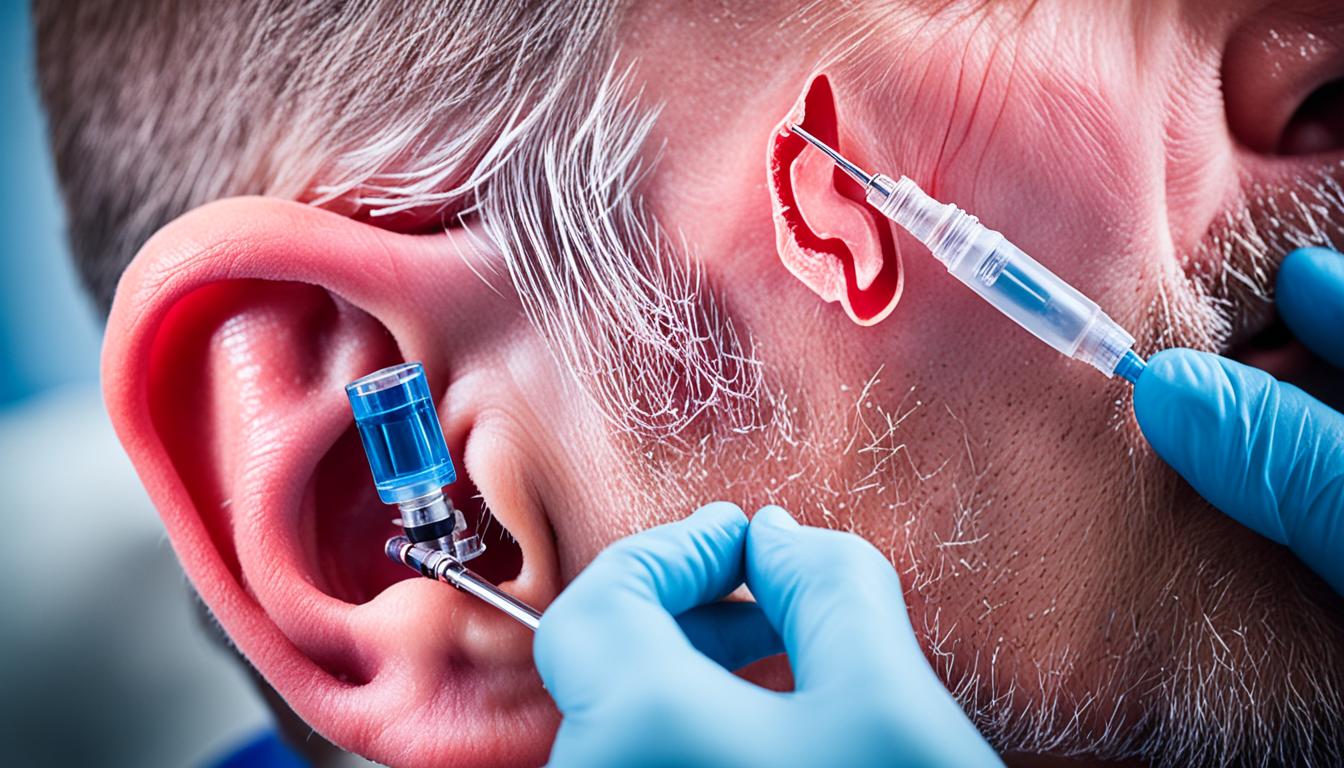A ruptured eardrum or a perforated eardrum is a tear in the eardrum. Various causes can lead to this issue. It might heal by itself in a few weeks. But, bigger holes may need help from a doctor. Signs of a perforated eardrum are sudden hearing loss, ear pain, and fluid coming from the ear. You might also feel like your ear is itchy, dizzy, or have trouble hearing for a while. If you think you have a perforated eardrum, and the symptoms last more than a few weeks, see a doctor.
Ear infections, sudden pressure changes, injuries to the ear, and loud noises can cause a ruptured eardrum. If not treated, it might lead to middle ear infections or hearing problems. Sometimes, surgery to fix the eardrum or stem cell therapy may help. Before these steps, doctors will focus on managing pain, stopping any infections, and talking about treatment options with you.
Key Takeaways:
- Ruptured eardrum, also known as a perforated eardrum, can heal on its own within a few weeks.
- Larger perforations may require medical intervention.
- Symptoms include sudden hearing loss, ear pain, fluid leakage, itching, dizziness, and temporary hearing loss.
- Causes of a ruptured eardrum include ear infections, pressure changes, injury, and exposure to loud noises.
- Complications can include middle ear infections, hearing loss, and chronic otitis media with cholesteatoma.
- Treatment options include pain relief, infection prevention, surgical repair, and potential stem cell therapy.
Symptoms and Diagnosis of Eardrum Ruptured
The symptoms of a ruptured eardrum can vary from person to person. Yet, there are common signs to watch for. These include sudden hearing loss, ear pain, or discomfort. You might also see fluid leaking from the ear, often with blood or pus.
There might be itching or dizziness, and sometimes you’ll lose hearing for a bit.
If you have any of these signs, see a doctor right away. You will need a proper diagnosis and the right treatment. An otolaryngologist will examine you thoroughly.
- Otoscope examination: An otoscope is used to visualize the eardrum and assess its condition.
- Tympanometry: Tympanometry is a test that measures the movement of the eardrum in response to changes in air pressure.
- Hearing test: A hearing test may be performed to evaluate the extent of hearing loss and determine if there are any other underlying issues.
They will use an otoscope, tympanometry, and possibly a hearing test. These checks will help figure out how bad the problem is. They also look for any additional issues you might have.
Ruptured Eardrum Symptoms
Signs of a ruptured eardrum are sudden hearing loss, ear pain, and fluid leaking from the ear. This might be with blood or pus. You could also feel an itch in the ear. Dizziness or vertigo and temporary hearing loss are also common.
Diagnosis of Ruptured Eardrum
Diagnosis involves an otoscope exam, tympanometry test, and hearing test. These help pinpoint the injury’s seriousness. They also look for other problems that might be there.
Complications and Treatment Options for Eardrum Ruptured
If a perforated eardrum doesn’t heal within 2 months, it might cause problems like ear infections and permanent hearing loss. Getting early medical help is key to stopping these issues and taking care of the ear.
Treating a ruptured eardrum aims to lessen pain and stop infections. Doctors might use antibiotics to fight off or stop infections, keep the ear dry and clean, or recommend surgical repair if needed.
Stem cell therapy is a newer way to fix the eardrum and enhance hearing. It uses stem cells to repair the damage. This method offers hope for a better and lasting answer for those with a ruptured eardrum.
For pain relief and to avoid more harm to the eardrum, keeping the ear clean and dry is vital. Also, don’t put anything in the ear and treat ear infections quickly. These steps help with healing and lessen the complication risk.
| Treatment Options | Description |
|---|---|
| Antibiotics | Prescribed to prevent or treat infections that can arise from a perforated eardrum |
| Surgical Repair | In cases where the eardrum does not heal on its own, surgical intervention may be required to repair the ruptured eardrum |
| Stem Cell Therapy | A promising treatment option that utilizes stem cells to promote healing and regeneration of damaged eardrum tissue |
| Pain Relief | Various pain management techniques and medications may be recommended to alleviate discomfort |
| Infection Prevention | Keeping the ear clean and dry, and promptly treating any ear infections, can help prevent further damage to the ruptured eardrum |
Knowing about the risks and treatments for a ruptured eardrum lets people act early. They can help protect their hearing and lessen the impact of this condition.
Conclusion
A ruptured eardrum, or perforated eardrum, is often caused by different things. This issue can make your ear hurt and cause fluid to come out. You might also find it hard to hear for a while.
Smaller holes in the eardrum can get better without needing a doctor’s help. But, if the hole is big, you might need medical care.
Doctors can help by easing your pain and preventing infections. They might even fix your eardrum with a surgery. One day, stem cell therapy could be a good way to heal your eardrum and make your hearing better.
Help yourself by avoiding things that can hurt your ears. Keep your ears dry and don’t put things in them. If you get an ear infection, treat it right away. This can stop more harm to your eardrum.
If you think your eardrum is broken or if your ear hurts and you can’t hear well, see a doctor. They can tell you what’s wrong and how to fix it.

